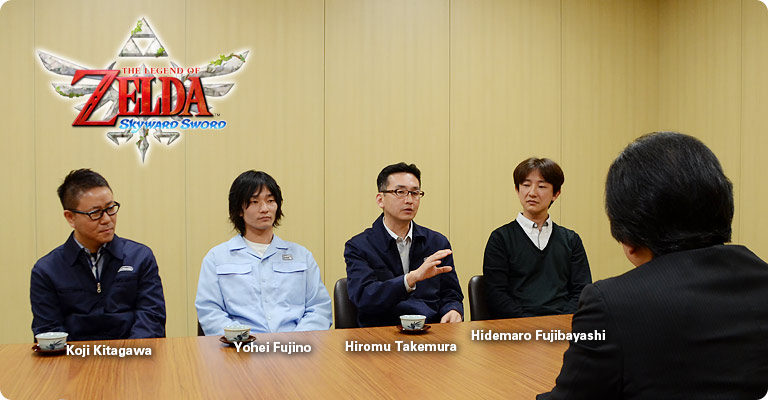Zelda: Skyward Sword details from the latest Iwata Asks
Posted on November 7, 2011 by Brian(@NE_Brian) in News, Wii
The fourth volume of the Iwata Asks interviews featuring Zelda: Skyward Sword has gone live. This time, the discussion focuses on the game’s desert areas. The information comes from Koji Kitagawa, Yohei Fujino, Hiromu Takemura, Hidemaro Fujibayashi, and Satoru Iwata.
– Unique “transformation system” used for the desert, so the team made three separate areas
– The desert becomes a sea
– You’ll need to use a boat once this happens
– The dungeon you head into is a stage set on a ship drifting around a desert sea
– Staff wanted to make the desert have gameplay that was of contrast
– Early on, the team researched/experimented making use of the Wii’s capabilities so players could go back/forth between the past/future in an instant, wherever and whenever they wanted
– Transformation system was a result of the experiment the team did for gameplay with contrast in the desert
– Cut through space and that becomes the past
– Strike a Timeshift Shone in the desert to turn the present into the past in a widening circle
– In the present, Link is in a desert region, with an ancient civilization lying underneath all the quicksand
– Hitting the Timeshift Stone reveals the civilization
– If you make a broken cart move after the transformation, you can’t use it in the present but when you return to the past, it works
– Characters/enemies in the desert area have robots running on electricity
– Team wondered if they would call it electricity in the Zelda world
– Tried to avoid a robot design that would look too mechanical
– Hesitation to put in anything mechanical originally
– The robots don’t seem out of place; Fujibayashi believes this is because of the designers’ skill
– Designers tried to give the robots a softer appearance
– There are puzzles you can’t see when you’re walking around in the present
– You’ll get an ancient map, so you understand how that area was long ago
– Then you overlap the present circumstances onto that
– Can’t advance into certain places due to the quicksand; ancient map shows there are ruins hidden underneath
– Map serves as a hint for making progress
– For the second desert area, Fujino thought of using Dowsing for something on the move rather than elements that stay still early on in the game
– This led to his thinking of using a big ship roving the seas and the player has to search for it
– Transformation system is vast in scope
– Takemura believed they could make a whole game out of the transformation system
– Third area may have the most transformation gameplay
– Two sets of data made for everything due to the system
– Use Wii MotionPlus in special ways to solve mechanisms in the desert
– Twist things and insert them
– Enemies are used to help solve puzzles
Source
– Ampilus enemy appears in the desert
– There was a ton of material, so the team decided to structure the desert into three areas
– There is a building important to the story in the desert
– The desert as a whole is the scene of a big turning point within the story
– It’s also a level up in swordplay, item use, and puzzle-solving
